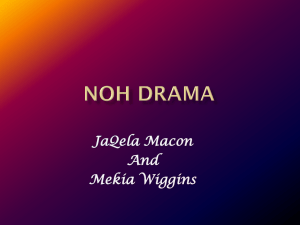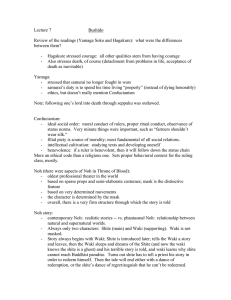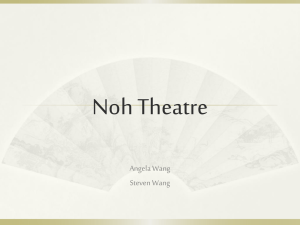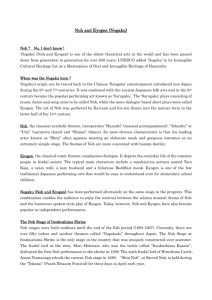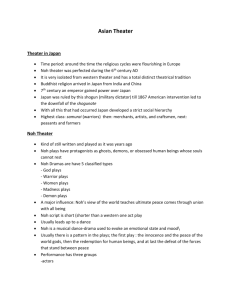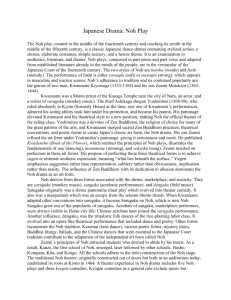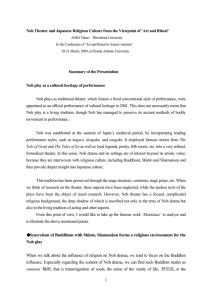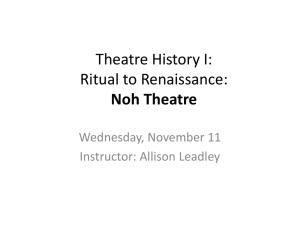Japanese Noh Theatre
advertisement
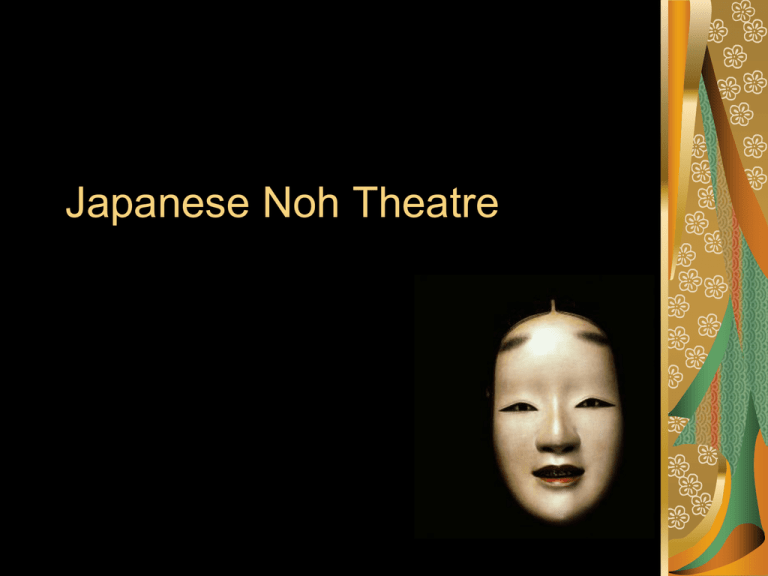
Japanese Noh Theatre What is Noh? Formed early 14th Century Oldest transmitted performance art in the world Integrated popular song and dance from the time period Influenced by Buddism Founded by Zeami (Zay-ahmee) Zeami One of the most influential figures in Japanese Theatre His treatise on Noh Fūshi kaden (Teachings on Style and the Flower) written 200 years before Shakespeare is still used today Simplicity Unlike Kabuki, Noh is based on simplicity No scenery and little if any props are used Audience is not separated by a curtain Chorus and musicians are onstage Instead of pursuing realism, Noh pursues the expression of inner movement through spoken word, music and dance in an extremely simplified space. Origins and history In China, “Sangaku” and “Gagaku” were two types of performance Sangaku – a public entertainment, included comical performances and parodies, acrobatic performances, juggling, and magic Gagaku – solemn music and dance, largely ceremonial in the imperial court and aristocrats’ residences. Sangaku spread among the commoners as entertainment performed at temples and shrines Sangaku becomes Saragaku - the basis for Noh showing that Noh was developed from juggling and acrobatic performance Origins and history It is uncertain when the word “Noh” emerged Noh was divided into “saragaku-no-Noh” (humorous mime) focusing on how skillfully the actor played the character and “dengaku-noNoh” which aimed to express subtleness and insight through dance and was more symbolic rather than copying the actual character Both forms organized performance groups led by a “master” Each master held great control – Zeami’s Fūshi kaden was probably written to pass down the artistry he acquired Kannami and zeami Kannami, a Noh master, added the kusemai (storytelling with dance) and singing and dance to sarugaku A few of his plays are still produced today Kannami’s son Zeami perfected his father’s work and gained support from the shogunate especially Shogun Ashikaga Yoshimitsu which led to great notoriety His refinements led to what is known as the Noh art form More than 50 of his dramas are still performed with his originally lyrics Forms and elements Most Noh dramas are based on popular classic stories among ordinary people Zeami’s stories fall under the style of “Mugen Noh” or “dreamy Noh” where the real world and the dream world crisscross. Although it can be difficult to follow, each Mugen Noh’s structure is similar so audiences can learn the pattern Structure of Mugen Noh A traveler visits a place and meets a local person The local person tells the traveler about a historic event and a story associated with a person at the locality At the end of the story, the person reveals that he or she is the historic person who was just described in the story, and then the person disappears. After this, the main character once withdraws backstage The main character later re-appears on the stage and "nochiba (the second half of the drama)" of the drama starts. The local person's ghost appears in the traveler's dream, dances to show the past event, and gradually disappears when the traveler wakes up. Characters in Noh The protagonist is called “shite” who plays a god, ghost of a samurai or woman, madwoman, or supernatural characters such as a goblin or the spirit of a dragon The “waki” is a side character and a living person The waki is often a wandering monk and/or a foe of the shite This creates a structure where a living person meets shite, a diseased character, who seeks salvation through the living person Noh has minimal characters, it is not unusual that a drama is played by two characters Five Categories of Noh Noh drama is classified into five categories: God – The shite takes the role of a god promising peace, happiness and fertility of all grains Man (warrior) – The shite often takes the role of a diseased man, such as the ghost of a samurai Woman – The shite appears as the ghost of a woman. Usually the love of the female ghost keeps her on earth and forces her to float around Five Categories of Noh Madness – The shite takes the role of a crazy person. Madness does not mean mental insanity but rather a situation in which a person becomes frantic by thinking too seriously. This category can also be referred as “miscellaneous” which includes stories which are not classified in other categories Demon – The shite peforms as a demon or spirit in an overwhelming dance accompanied with drums and spectacular music The noh stage The noh stage A Noh stage is an extremely simplified space which does not have a drop or drawn curtain between the stage and the auditorium (kensho). Originally performed outdoors, but is now indoors designed to look like the open air stage, equipped with a roof, a gangway bridge (hashigakari), and pine trees planted on the bridge in perspective Modest lighting to recreate natural light. In many cases, large jars are buried under the main stage and the gangway bridge. These jars function not only to enlarge and improve the sound of stepping, music and speaking The noh stage The noh stage Columns provide markers for shite who has limited vision due to the mask Kagami-ita (back board) always a pine tree Jiutai-za – chorus seating Ato-za – seating for musicians (hayashi) Koken – seating for stage managers Hashigakari – gangway bridge used as a walkway and for scenes Agemaku – curtain for characters (kiritoguchi for chorus, musicians and sm’s) Kagami-no-ma – backstage Kensho – audience seating Masks 60 basic types of masks and over 200 different kinds of masks Covering the face with a mask is related to the transformation of a person, just like make-up. It is said that a Noh mask has an element of spell, which provides spiritual power to the Noh actor. The Noh mask is called omote. Only the shite or his compainion (tsure) don masks The waki is a living character and therefore does not Usually, there is no mask assigned to a character. Rather, the type of masks to be used is designated for each drama. Therefore, it depends on the shite to decide which mask he will use Masks It is unclear when Noh masks emerged. Originally based more on religious tastes than artistic As the focus towards subtlety grew, performers felt more and more need to conceal the change of their facial expressions and the ugliness of their aged faces As Noh grew towards the modern age, mask designs grew significantly as mask makers became an independent occupation Mask expressions Emotional expression is extremely difficult Noh actors give expression through the well known gestures “teru” and “kumoru” Terasu – raising the face slightly upwards makes the mask appear to smile Kumorasu – lowering the face slightly downward makes the mask appear to weep Simple and miniscule movements of the mask expresses the subtleties of human emotion Types of masks Jo Elder Types of masks Otoko Man Types of masks Onna Woman Types of masks Kishin Demon Types of masks Kishin Demon Types of masks Onryo Ghost & Spirit Types of masks Onryo Ghost & Spirit Props As a rule props are seldom used on stage The only exception is the “tsukurimono” “Tsukurimono” are large stage props used to symbolize a house, grave, ship, bed, etc Built of a bamboo frame it is meant to be symbolic of the item rather than recreate it Props Ship Cobweb Chants and music Music is composed of vocal (utai) and instrumental (hayashi) The utai is performed by the actors or the Jiutai (chorus) who describe the events, scenery and emotion of the characters, but are NOT characters on stage There is musical scale in utai but rather determined by the shite or choral leader Chants and music The hayashi is composed of four instruments Fue or Nohkan - flute Kotsuzumi – small hand or shoulder drum Ozutsumi – large hand drum Taiko – drum beaten with sticks http://www2.ntj.jac.go.jp/unesco/noh/e n/roles_musical.html Dance and forms To perform Noh is “to dance Noh” Specific parts of the drama also include dance (mai) which is dance and music combined Several types of specific dances are performed in each play from the slow dance of the woman to the very fast dance of the demon Even basic blocking is extremely detailed and done with precise movements costume The costume is called Noh shozoku A typical costume include the karaori (outer robe) which is extremely ornate There are many rules for the color and style of costume The shite decides what the wears on stage as long as they follow the rules costume
